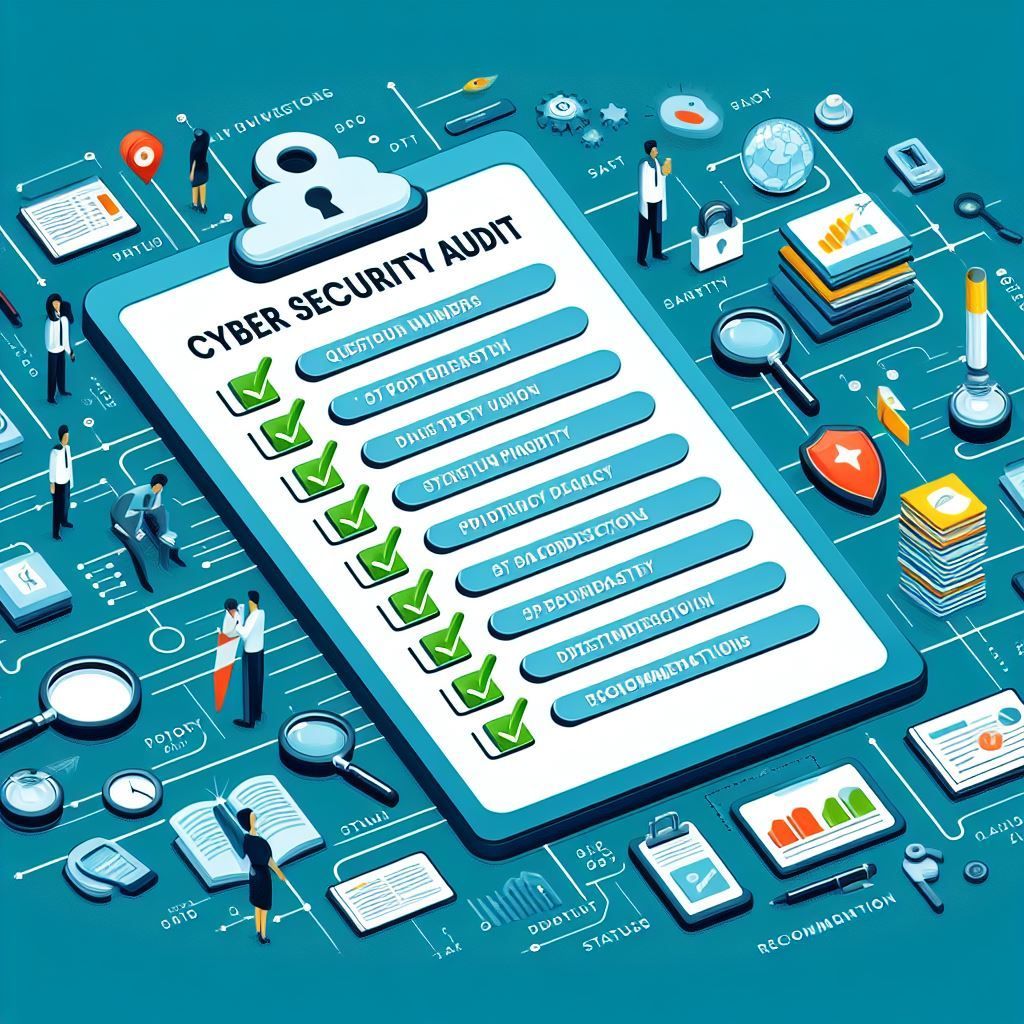How Much Cyber Insurance Do I Need: Part 3 of 3 - Coverage Checklist
Your Guide To How Much Cyber Insurance Do I Need?
Part 3 of 3
Cyber Insurance Coverage Checklist
Introduction: Securing the Future for SMEs
The exponential complexities of
cyber security and insurance have become a critical aspect for small to medium-sized businesses. Understanding the role of insurance agents, being aware of common policy loopholes, and aligning cybersecurity measures with
insurance requirements are fundamental steps in ensuring comprehensive coverage. In the final part of our three part series we offer insights on how much cyber insurance do I need, selecting the right cyber insurance policy, understanding coverage limits, and reinforcing best practices in cybersecurity to safeguard against evolving threats.

Navigating Cyber Insurance: Understand the role of insurance agents in the realm of cyber insurance and why it's crucial to thoroughly review policies for potential loopholes that could affect your coverage.
What specific training or qualifications should an insurance agent have to effectively guide a business in selecting the right cyber insurance policy, considering the unique cyber threats and risk profiles in various industries? This is a common question in the cyber insurance questionnaire and one of many important cyber insurance questions that need clear answers.

Cybersecurity Knowledge: A deep understanding of cybersecurity principles and current threat landscapes is crucial. An agent should be well-versed in various types of cyber risks, such as data breaches, ransomware attacks, and social engineering tactics. This knowledge enables them to accurately assess the risks a particular business might face.
Industry-Specific Expertise: Different industries face unique cyber threats. For instance, a retail business might be more prone to point-of-sale breaches, while a healthcare organization could be more vulnerable to data breaches involving sensitive patient information. An agent should have expertise relevant to the specific industries they are advising.
Understanding of Cyber Insurance Policies: Proficiency in the language, coverages, exclusions, and conditions of cyber insurance policies is essential. Agents should be able to interpret policy language accurately and identify potential gaps in coverage, as demonstrated by a cyber insurance policy sample.
Continual Learning and Certification: The field of cybersecurity is rapidly evolving. Agents should engage in continual learning and professional development. Certifications like Certified Cyber Insurance Specialist (CCIS) or participation in cybersecurity seminars and workshops can be indicative of their commitment to staying updated, which is crucial in cyber insurance underwriting.
Experience in Risk Assessment and Management: Practical experience in conducting cyber insurance risk assessments and developing risk management strategies is beneficial. This helps in aligning a client's specific risk profile with the most suitable insurance policy.
Legal and Regulatory Awareness: Knowledge of legal and regulatory requirements related to cybersecurity and data protection (like GDPR, HIPAA, etc.) is important, as these factors significantly influence the cyber liability insurance requirements.
Interpersonal and Consultative Skills: Beyond technical knowledge, an agent should possess strong consultative skills to effectively communicate complex cyber insurance concepts to clients who may not have a technical background.
Can you provide examples of common loopholes or exclusions in cyber insurance policies that businesses often overlook, and how can these impact the level of coverage in the event of a cyber incident?

Exclusion of Certain Types of Attacks: Policies may not cover all types of cyber attacks. For example, while ransomware might be covered, some policies might exclude other attack vectors, like social engineering or phishing. If a business falls victim to an excluded type of attack, they may not be covered by their policy. A thorough cyber insurance risk assessment should reveal these exclusions.
Requirement for Regular Software Updates: The importance of having updated end-point protection and firewalls is highlighted. Many cyber insurance policies mandate that businesses maintain up-to-date software and security systems. Failure to do so can lead to a denial of a claim if a cyber incident occurs due to outdated systems.
Conditions for Ransomware Payment Coverage: In discussing ransomware, it's mentioned how insurance might cover the loss incurred per day. However, some policies have specific conditions for covering ransomware payments, or they might exclude such payments. This can leave a business responsible for the cost of the ransom, underlining the importance of a cyber insurance readiness evaluation.
Compliance with Security Protocols: The need for robust cybersecurity practices, like using complex passwords and not sharing them over the phone, is emphasized. Some policies require adherence to certain security protocols. A breach resulting from non-compliance could result in a claim being denied.
Limitations on Business Interruption Coverage: While policies might cover business losses due to a cyber attack, there could be limitations, such as a waiting period before coverage starts or caps on the amount covered per day of interruption.
Exclusion of Insider Threats: Incidents caused by insiders, whether intentional or accidental, might be excluded from policies. If an employee’s actions lead to a breach, the policy may not provide coverage, depending on its terms.
How can a business effectively assess and align its current cybersecurity measures with the requirements of a cyber insurance policy to ensure maximum coverage and minimal risk of voiding the policy due to non-compliance?

Conduct a Thorough Risk Assessment: Start with a comprehensive evaluation of your current cybersecurity posture. Identify potential vulnerabilities, such as outdated software, weak password policies, or lack of employee training. Understanding where your business stands in terms of cybersecurity is crucial for aligning with insurance policy requirements.
Review Policy Requirements in Detail: Carefully read the cyber insurance policy to understand its specific requirements. Look for clauses that mandate certain security measures, such as regular software updates, use of firewalls and endpoint protection, and employee cybersecurity training.
Consult with Cybersecurity Experts: Engaging with cybersecurity professionals can provide valuable insights. They can help interpret the policy’s requirements in the context of your business and suggest practical measures to comply with them. As mentioned in the conversation, these experts can review your policy and provide guidance on its applicability and sufficiency.
Align Cybersecurity Practices with Policy Requirements: Update your cybersecurity practices to meet the policy requirements. This might include implementing stronger password policies, ensuring regular software updates, setting up two-factor authentication, and training employees on cybersecurity best practices.
Regularly Update and Document Cybersecurity Measures: Cyber threats evolve constantly, so it's important to keep your cybersecurity measures up-to-date. Regularly review and update your practices and keep detailed records of these updates. Documentation is key in demonstrating compliance with the insurance policy.
Employee Training and Awareness: Educate your employees about cyber threats and the importance of following security protocols. The conversation highlighted how breaches often occur due to employee actions, like sharing passwords. Regular training can mitigate this risk.
Periodic Reviews and Audits: Regularly review and audit your cybersecurity measures to ensure they align with the policy requirements. This proactive approach helps in identifying and addressing any gaps before they become issues.
Communicate with Your Insurance Provider: Maintain open communication with your insurance provider. If you’re unsure about certain requirements or need clarification on policy terms, don’t hesitate to ask them for explanations or guidance.
Understanding Cyber Extortion Coverage: Learn about the intricacies of how cyber insurance policies typically handle cyber extortion and ransomware attacks, focusing on coverage limits and the kind of losses they cover.
What are the typical coverage limits in cyber insurance policies for cyber extortion and ransomware attacks, and how do these limits affect the overall financial protection offered to businesses?

As an example, a small to medium-sized business might find cyber insurance policies offering coverage limits ranging from $100,000 to $1 million for ransomware attacks. This means that in the event of an attack, the policy would cover expenses and losses up to the specified limit. When assessing how much cyber insurance do I need, it's crucial to consider these limits. Let's say a policy has a coverage limit of $500,000; this cap is crucial as it determines the maximum payout by the insurance company. If the daily operational loss of the business due to a ransomware attack is $10,000, and the business is unable to operate for 50 days, the total loss would amount to $500,000, which falls under the policy limit and hence would be fully covered.
However, if the coverage limit is lower than the potential loss, the business will have to bear the excess cost. For instance, if the same business has a policy with a $250,000 limit but incurs losses of $500,000, it will have to cover the remaining $250,000 out of pocket. This scenario underscores the importance of selecting a coverage limit that aligns closely with the potential financial risks the business faces. Additionally, businesses should be aware of any deductibles and coinsurance clauses, which could further influence the out-of-pocket costs during a claim. Therefore, careful evaluation of potential risks, daily operational values, and revenue streams is essential for businesses when determining appropriate coverage limits in their cyber insurance policies.
Post-Attack Strategies: Hear about real-life scenarios, like the MGM cyber attack, and the lessons learned from such incidents. Understand the importance of end-user training, robust policies, and practices to prevent credential theft.

What specific lessons can businesses learn from real-life cyber incidents like the MGM attack, particularly regarding the effectiveness of end-user training and robust policies in preventing credential theft?
The MGM incident, as described, involved a simple yet effective social engineering technique, where a hacker impersonated an employee over the phone to gain access to sensitive systems. This highlights the paramount importance of training employees to recognize and respond to such tactics. End-user training should emphasize the criticality of verifying identities and following strict protocols before sharing sensitive information or credentials. Regular and comprehensive training can significantly reduce the risk of employees inadvertently facilitating a cyber attack.
How can implementing robust policies and practices based on real-life cyber attack scenarios, such as the MGM incident, enhance a business's resilience against similar future cyber threats?
The MGM attack demonstrates the dangers of a 'flat network' where once access is gained, an attacker can easily navigate to various critical systems. To prevent similar incidents, businesses should adopt network segmentation, ensuring sensitive areas of their network are isolated and more secure. Additionally, establishing strict policies like not sharing passwords over the phone and enforcing two-factor authentication (2FA) are key strategies. These policies, alongside regular security audits and updates to IT infrastructure, can significantly fortify a business against various cyber threats.
Cybersecurity Best Practices: Get expert advice on essential cybersecurity practices, including network segmentation, password policies, and the use of two-factor authentication (2FA) to strengthen your defense against cyber threats.

What are the key benefits of implementing network segmentation, strong password policies, and two-factor authentication (2FA) as part of a business's cybersecurity strategy?
Network segmentation enhances security by dividing a network into smaller, controlled segments, thereby limiting an attacker's access in the event of a breach, as demonstrated in the discussed scenario. This approach helps in containing threats and minimizing the impact on the entire network. Strong password policies prevent unauthorized access by ensuring that passwords are complex and changed regularly, reducing the likelihood of credential theft. Two-factor authentication adds an additional layer of security, as it requires a second form of verification beyond just a password. This is particularly effective against attacks like phishing, where credentials might be compromised.
How can businesses effectively implement and manage these essential cybersecurity practices to maximize their defense against cyber threats?
Starting with network segmentation, IT teams should identify critical assets and segregate them into different network zones, each with its own security controls. For password policies, businesses should enforce guidelines that mandate the use of strong, unique passwords and regular updates, possibly through automated password management tools. Implementing two-factor authentication involves choosing the right method (like SMS codes, authenticator apps, or hardware tokens) that aligns with the business's operations and ensuring all users are adequately trained to use it. Regular audits and reviews of these practices are essential to ensure they remain effective and updated in line with evolving cyber threats.
Engaging with Cybersecurity Specialists: Find out how small to medium-sized businesses can benefit from initial cybersecurity audits at no cost and the importance of staying updated with the latest security measures.

How can small to medium-sized businesses benefit from initial, no-cost cybersecurity audits conducted by specialists?
Audits provide a valuable overview of the current security posture of the business, identifying potential vulnerabilities and areas for improvement. As mentioned in the conversation, specialists can ask pertinent questions about existing security measures, like the status of firewalls and endpoint protection. This initial evaluation helps businesses understand where they stand in terms of cybersecurity and what actions they need to take to enhance their security. It serves as a crucial first step in developing a robust cybersecurity strategy, particularly for smaller businesses that may lack the resources or expertise to conduct such assessments internally. Moreover, these audits can also help businesses align with the requirements of cyber insurance policies, ensuring they are adequately protected and compliant.
Why is it crucial for these businesses to stay updated with the latest security measures in their cybersecurity strategy?
As technology advances and cybercriminals become more sophisticated, outdated security measures can quickly become ineffective. Regularly updating security protocols, software, and hardware ensures that businesses are protected against the latest types of cyber attacks. In Dave’s video he underscores the importance of continually evolving security measures, such as updating firewalls, implementing advanced endpoint protection, and ensuring regular employee training on the latest cybersecurity threats and best practices.
How can IT professionals and small to medium-sized business owners collaborate to implement Dave’s recommended cooperative approach for identifying and mitigating security risks, and what are the top three must-do actions they should prioritize to prepare for cyber insurance effectively?

To effectively implement Dave’s cooperative approach, IT professionals and business owners need to establish a partnership based on open communication and mutual understanding. This collaboration starts with acknowledging the challenges faced by IT teams and providing them with the necessary support and resources. Regular cybersecurity audits are a key action item, crucial for uncovering vulnerabilities and assessing current security measures. While these audits might be challenging for IT teams, they play a pivotal role in strengthening cybersecurity defenses, an essential factor in qualifying for cyber insurance.
Additionally, IT professionals should focus on updating and enforcing robust security policies, such as regular software updates, strong password management, and two-factor authentication. Business owners can facilitate this by prioritizing cybersecurity in their business strategy and ensuring that the necessary resources are allocated. This combined effort not only enhances the overall cybersecurity posture of the company but also aligns with the requirements of cyber insurance policies, providing a solid foundation for effective cyber risk management.
Final Thoughts: The Essential Balance of Cyber Insurance and Robust Security Measures

Cyber insurance requires a multifaceted approach that involves understanding the role of insurance agents, being mindful of policy loopholes, and aligning cybersecurity measures with insurance requirements. A pivotal question that businesses must address is "how much cyber insurance do I need?" which is determined through a careful evaluation of potential risks and the necessary coverage to mitigate the financial impacts of potential cyber incidents. By doing so, businesses not only enhance their protection against cyber threats but also ensure they are adequately insured. Engaging with cybersecurity experts and staying updated with the latest security measures further fortifies a business's cybersecurity posture, making it an indispensable part of modern business strategy.
If you would like to learn more about cyber security and partnering for your cyber insurance needs please check out additional blog articles or contact us.
Thank you and stay safe!


We'll help provide the right security solutions for you.
Helping IT Managers to Chief Information Security Officers (CISOs) with security solutions, user training, and support so you can focus on the big picture.
CONTACT US
(651) 964-0040
support@essential-consulting.com
218 5th St E, Northfield, MN 55057
USEFUL LINKS
STAY INFORMED
You need a helping hand with your project?
We will get back to you as soon as possible
Please try again later

